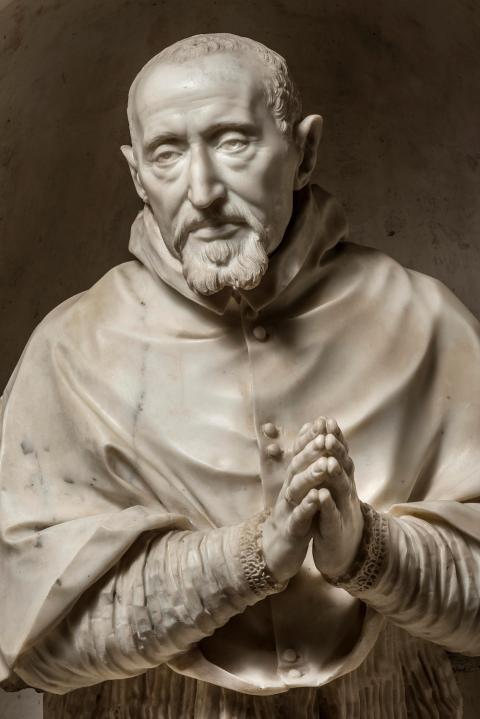
Painted Model for the Apse Fresco of the Gesù by Giovanni Battista Gaulli (Fairfield University/Zeno Colantoni)
A new exhibition at a Catholic university in Connecticut will tell the story of a dramatic period in the history of one of the Catholic Church's most visible religious orders, as it also introduces important and historical art to the United States for the first time in history.
To help celebrate the 75th anniversary of its founding in 1942, Fairfield University, a Jesuit institution, is hosting "The Holy Name: Art of the Gesù: Bernini and His Age" in Bellarmine Hall Galleries until May. Since the exhibition opened in February, the university's art museum has had on display dozens of important works related to the Chiesa del Santissimo Nome di Gesù all'Argentina, commonly known as the Gesù, the mother church of the Society of Jesus.
Linda Wolk-Simon, director and chief curator of the Fairfield University Art Museum, says that she had the idea to hold the exhibition shortly after she began working at Fairfield in early 2015, with just enough time to make it a reality.
"By any other standards, [two years] sounds like kind of a long time, but actually, by museum standards, for a show of this scope it's a very short lead time," she told NCR. "It's not just a matter of sending an email and asking for the loan and getting it approved; it's a long negotiation process in many cases."
Some of the works on display come from nearby museums. Five of them, including a bust by the great 17th-century sculptor Gian Lorenzo Bernini of Jesuit Cardinal Robert Bellarmine (1542-1621), one of the most important churchmen of his day and Fairfield's patron saint, were delivered from the Gesù itself.
In addition to the bust, which left the Gesù for the first time for Fairfield's show, a chasuble of the Gesù's benefactor Cardinal Alessandro Farnese, a bronze statuette of St. Teresa of Avila, a model of the Gesù's apse fresco by Giovanni Battista Gaulli, who would ultimately replicate the work as a fresco in the church, and an altar set of the society's founder, Ignatius of Loyola, round out the list of items shipped from the great church.
While these pieces are of much interest, "the key thing, rather than individual pieces, is the whole thing together," the chief curator of the Frick Collection, Xavier Salomon, who also serves in an advisory role with Fairfield, told NCR. "The fact that you have so much from around the decoration and art of this church all in one place I think is absolutely amazing."
Additional featured works come from more than 20 other prestigious collections, like Yale University and Princeton University's museums, the Metropolitan Museum of Art, and the Art Institute of Chicago, among others. More of Bernini and Gaulli's work appear as well.
Advertisement
The Gesù was constructed in the late 16th century; ground was broken for the new church in the summer of 1568 and it was dedicated in the fall of 1584. After struggling to secure funding for some time, the order ultimately found patronage from Farnese, whose family was powerful in Italy; Pope Paul III was his grandfather.
Going back to its founders, Ignatius and his companions, the order always had a strong devotion to the Holy Name of Jesus, even asking the pope to be given the name themselves. The pope granted their wish, and the devotion gave the mother church its name.
Today, "besides St. Peter's and the great basilicas, the Gesù is up there among the top five churches in Rome," Salomon said. In addition to the outstanding art and architecture the church possesses, the remains of Ignatius are also buried there.

Bust of Cardinal Roberto Bellarmino by Gian Lorenzo Bernini (Fairfield University / Zeno Colantoni)
The interior was relatively unornate at first, but as the young society started to expand, with many of its members recognized as saints or important churchmen, and the work of great artists was added, the Gesù became a much grander and more significant treasure of the church.
"There was this huge push to get this church built," Wolk-Simon said, "then a period of waiting, then another huge push a century later to get the interior decorated."
"The Gesù is not just another pretty church in Rome," Jesuit Fr. John O'Malley, a historian and professor of theology at Georgetown University and co-author of The Jesuits and the Arts, 1540-1773, told NCR. "It's the first brand new church constructed in Rome for several hundred years, and it was immediately imitated throughout the world."
As the first church constructed by the order, the church of its superior general, and the burial place of its founder, the Gesù also came to be known as the society's "mother church."
Although only personally responsible for a few of the works in the show, Bernini was such an accomplished artist in his day that his "influence could be felt throughout Rome in the 17th century and it really spread all over Europe," Salomon says. "If there is one overarching artistic figure that has left a huge legacy [in the show], that is clearly Bernini."
The artist worked with the Jesuits off and on throughout his life. He was a close friend of Giovanni Paolo Oliva, the order's superior general for more than 17 years before his death in November 1681. Among Bernini's contributions to the Gesù was his introduction of Oliva to Gaulli, who went on to paint the striking ceiling fresco.
A book bearing the same name as the exhibition and edited by Wolk-Simon, with essays on the various pieces on display, is also being published to coincide with the show.
Fairfield's art museum is relatively small, but Salomon credits Wolk-Simon, "the hero behind this whole story," for making the exhibition happen, as well as Fairfield for "believing in her and supporting the project."
"The combination of the university and her vision has created this extraordinary event," he said. "This is a show that should be happening at the Metropolitan Museum, that should be happening at major museums on the East Coast, and instead it's happening at this very small university museum … that's what's so great about this project."
"The Holy Name: Art of the Gesù: Bernini and His Age" will be at Fairfield University Art Museum's Bellarmine Hall Galleries until May 19.
[James Dearie is an NCR Bertelsen intern.]








